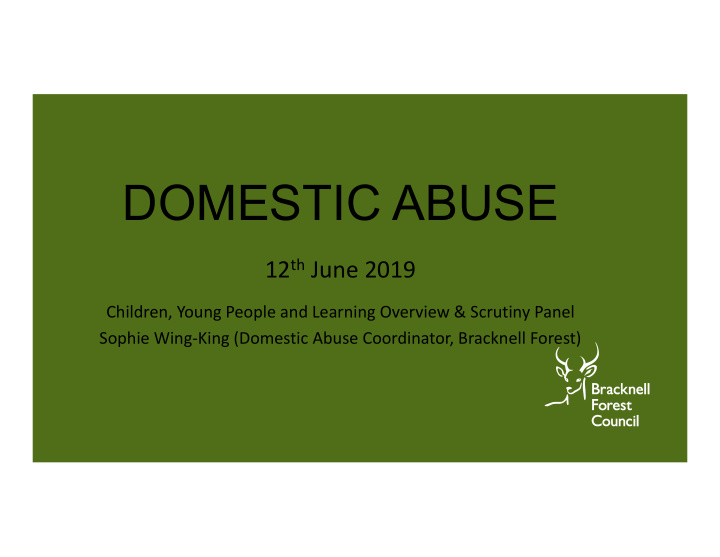



DOMESTIC ABUSE 12 th June 2019 Children, Young People and Learning Overview & Scrutiny Panel Sophie Wing-King (Domestic Abuse Coordinator, Bracknell Forest)
DEFINITION ‘Any incident or pattern of incidents of controlling, coercive or threatening behaviour, violence or abuse between those aged 16 or over who are or have been intimate partners or family members* regardless of gender or sexuality. This can encompass, but is not limited to, the following types of abuse: psychological, physical, sexual, financial, emotional’ *Family members are: mother, father, son, daughter, brother, sister & grandparents; directly-related, in-laws or step-family
• Controlling behaviour is: a range of acts designed to make a person subordinate and/or dependent by isolating them from sources of support, exploiting their resources and capacities for personal gain, depriving them of the means needed for independence, resistance and escape and regulating their everyday behaviour • Coercive behaviour is: a continuing act or a pattern of acts of assault, threats, humiliation and intimidation or other abuse that is used to harm, punish, or frighten their victim • The Government definition, which is not a legal definition, includes so called 'honour’ based violence, female genital mutilation (FGM) and forced marriage, and is clear that victims are not confined to one gender or ethnic group
• 9 times more effective in predicting homicides than threats and violence • The whole point of coercive control is to stop the victim leaving or to stop loss of control over them - Conditioning, Dependence, Entrapment
PREVALENCE • 2.0 million adults (16-59yrs) experienced domestic abuse in the last year (ending March 2018) – 1.3 million women (7.9% of population) – 695,000 men (4.2% of population) • 400 domestic homicides (April 2014 - March 2017) 25% of all homicides, victim age 16+ • On average every 30 seconds someone contacts the police for assistance with domestic abuse (HMIC, 2014)
• Domestic abuse can start during pregnancy and existing abuse may get worse • 130,000 children in the UK live in households with high-risk domestic abuse • Two in five children (41%) in families where there is domestic abuse have been living with that abuse since they were born – over a third of these were over 5 years old • 25% of children in high risk DA households are under 3 years old. On average, high risk victims live with DA for 2.6 years and medium risk 3 years before getting help
• At least one child in every reception school class has been living with abuse for their whole life • 21 children intentionally killed by a parent with a known history of domestic abuse in circumstances relating to child contact – either formally or informally arranged (2005-19) • 27% of girls aged 11-21 years know girls who have experienced control/bullying from a partner • 23% of girls aged 11-21 years know girls who have experienced violence from a partner
THAMES VALLEY POLICE Domestic Abuse Crime and Non Crime Occurrences (Thames Valley Police, Bracknell Forest) Number of DA reports to TVP 2500 2000 1500 1000 500 0 2016-17 2017-18 2018-19 DA Crimes 529 561 937 DA Non Crimes 1697 1451 1044 Total 2226 2012 1981 • 2018-19 TVP repeat rate = 29.0%
2018-19 • 213 new referrals Adult IDVA (high risk) – 65 Outreach (standard & medium risk) – 148 • Age 16-84 yrs old • Majority female (94%) • 70% clients (n=148) had children (n=300), 32% under 5 yrs old
GOVERNANCE & PROVISION • Executive Group and Forum • Strategy: prevention; provision of services; partnership working; pursuing perpetrators • Training • Specialist domestic abuse support • Work with perpetrators (DAPS, Plain Talking, PRP)
• Group work for adults (Choices, Freedom, Recovery) • Support for children (DART, Recovery Toolkit, SAFE!) • Healthy Relationships • Information sharing & multi-agency work (MARAC, DASC, Family Safeguarding Model) • East Berkshire / Thames Valley
• Awareness raising
ANY QUESTIONS? Sophie Wing-King 07977 209879 Sophie.wingking@thamesvalley.pnn.police.uk
Recommend
More recommend